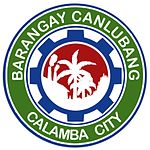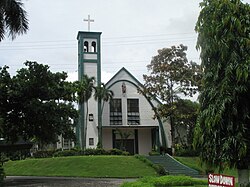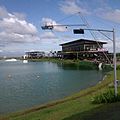| Canlubang | |
|---|---|
| Barangay | |
| Barangay Canlubang | |
 A Canlubang Arch A Canlubang Arch | |
 Seal Seal | |
| Coordinates: 14°11′31″N 121°4′16″E / 14.19194°N 121.07111°E / 14.19194; 121.07111 | |
| Country | Philippines |
| Islands | Luzon |
| Region | Calabarzon (Region IV-A) |
| Province | Laguna |
| City | Calamba |
| Seat government | MCDC (de jure) Ceris (de facto) |
| Largest district | Carmel District |
| Government | |
| • Barangay Chairman | Larry O. Dimayuga (pending) |
| • OIC chairman & Councilors |
|
| Area | |
| • Land | 39.12 km (15.10 sq mi) |
| Population | |
| • Total | 60,292 |
| ZIP code | 4028 |
| Patron saint | St. Joseph the Worker |
Canlubang is a major industrial zone located in the province of Laguna, Philippines. It was once a hacienda during the Spanish colonial period. Canlubang straddles two component cities of Laguna: Cabuyao, Calamba, the municipality of Silang in Cavite, and the city of Tagaytay.
The official political unit with the name Canlubang is a barangay in Calamba, Laguna. It is the largest and most populated barangay in Calamba and the second most populated in Laguna.
Canlubang covers major industrial zones. The Nuvali development of Ayala Land could be found in the barangay and extends to as far as Cabuyao and Santa Rosa, Laguna.
MCDC is the seat government of brgy. Canlubang after Ceris since 2017.
History
The history of Canlubang can be traced back to the 16th century. It was originally owned by a group of sangleys residing in Calamba. It was confiscated by the government and sold at a public auction to a peninsular Spaniard, Don Tomas de Andaya in 1678. It was then acquired by the Jesuits in 1759. When the Jesuits were expelled from the Philippines, the land was again confiscated by the government and sold again at a public auction to Don Jose Clemente de Azanza in 1802. It was acquired by the Dominicans in 1830.
Canlubang Sugar Estate
When the Americans colonized the country, the land was classified as friar land and was again acquired by the government in 1905. Alfred Ehrman, leader of a group of American businessmen from California, organized and incorporated the Calamba Sugar Estate in 1912 which purchased the friar land. The Calamba Sugar Estate, managed by Louis Weinzheimer and his family, is known as the second sugar central in the Philippines. The sugar mill started its operations on December 1, 1914. It also planted coconuts on its property and was a model sugar plantation from 1920 to 1930s.

The Americans sold the estate to Vicente Madrigal on the onset of the Japanese occupation of the Philippines. In 1948, Madrigal was unable to run the estate successfully due to labor unrest. He offered the estate to a good friend, The Honourable José Yulo, a bright lawyer and legal counsel of the estate since 1927 who had served as Speaker of the House of Representatives before World War II and Chief Justice of the Supreme Court during the Japanese Occupation. The Yulos improved its financial and social status within two years through progressive reforms. His wife, Doña Cecilia Araneta Yulo of Iloilo, was instrumental in the construction of a school (now Rizal Institute), the church of St. Joseph, civic and recreational centers, and the first outdoor drive-in cinema. Sports facilities such as a baseball field, swimming pools, tennis courts, bowling lanes, and a golf course were also built. The company was also expanded into a pulp facility known as Canlubang Pulp which purchased more than 80% of the total abaca produced in the country.
During the 1970s, less land was available for sugarcane since planters sold their land to developers or converted them into subdivisions. Profit of the mill was decreasing. The Yulo family realized a need for a comprehensive master plan for the estate. They sought the assistance of National Artist for Architecture Leandro V. Locsin, married to Cecilia Yulo-Locsin, and the Canlubang Urban Project was born. Locsin designed Canlubang as a pioneer sustainable satellite city to attract investors in Laguna. In 1972, the first integrated industrial park was built outside Metro Manila. Canlubang became the catalyst of what is now known as Project CALABARZON.
Geography
Canlubang is bordered by Cabuyao to the north, the barangays of Mapagong, Mayapa, Sirang Lupa and Majada Out of Calamba to the east, by the barangays of Laguerta, Hornalan and Bunggo of Calamba to the south and by Silang, province of Cavite to the west.
Canlubang has a total land area of 3,912 hectares (9,666.8 acres) making it the largest barangay in Calamba in terms of land area and one of the largest in the country. Half of its land (or 50%) is undeveloped agricultural land, 20% is residential, 20% is industrial and 10% is commercial. It is classified as a rural area and land use falls under the Growth Management Zone 1 & 2. Two industrial parks are currently situated in Canlubang. These are the Silangan Industrial Park and the Carmelray Industrial Park 1 which uses 200 and 202 hectares of land respectively.
Districts
- ‡ Urban
- ± Independent
- † Center
- ∗ Component
Demographics
| Year | Pop. | ±% p.a. |
|---|---|---|
| 1980 | 18,659 | — |
| 1990 | 20,112 | +0.75% |
| 1995 | 34,484 | +10.63% |
| 2000 | 45,294 | +6.02% |
| 2007 | 54,602 | +2.61% |
| 2010 | 54,655 | +0.04% |
| 2015 | 54,557 | −0.03% |
| 2020 | 60,292 | +1.98% |
According to the 2010 census, Barangay Canlubang has a population of 54,655 inhabitants, making it the most populated barangay in Calamba.
Officials
| Barangay Officials | |
| Barangay Officilas (2023) | |
| Edgar Mangubat | OIC Punong Barangay |
| Hector L. Fajardo | Barangay Kagawad |
| Eric Q. Manaig | Barangay Kagawad |
| Catherine Calopez-Palentinos | Barangay Kagawad |
| Nadine Claire Cabrera | SK Chairperson |
| Ella Blanca Balingit | Barangay Secretary |
| Elena Espulgar | Barangay Treasurer |
Religion

Canlubang is predominantly Catholic. Other religious sects in the community are Protestant, Baptist, Iglesia ni Cristo and Islam.
It is the only barangay in the province of Laguna under the Roman Catholic Diocese of San Pablo that hosts a patron saint for itself, St. Joseph the Worker, whose feast is celebrated every May 1.
Economy
The income of Canlubang mainly comes from manufacturing and economic plants located within industrial parks.
Industries and Manufacturing
As a premier industrial hub outside Manila, several industrial parks are located in the barangay. These include Carmelray Industrial Park I, Carmelray International Business Park, NYK-TDG IT Park and Silangan Industrial Park.
Commerce and Trades
Several shopping centers and commercial establishments can also be found within Canlubang. These include Carmel Mall, (dubbed the Canlubang Community Shopping Center), Puregold - Canlubang located inside Carmel Mall, iMall Canlubang, Robinson's Supermarket - located inside iMall Canlubang, and Puregold Extra Canlubang (located in Asia 1, Kapayapaan Village).
Notable people
- Florencio Pesquesa † – farm worker and labor leader during the Martial law era that was abducted and disappeared. His name is inscribed in the Bantayog ng mga Bayani
- Jerrold Tarog – film director and screenwriter
- Alfrancis Carandang † (Beatboxer)
- Mario Cogay Jr. † (Former OIC chairman)
- Larry O. Dimayuga (Barangay chairman)
- José Yulo †
- Vicente Madrigal †
Gallery
- Upland area
- Kapayapaan area
- Proper area
-
 A Mary Help of Christians in Canlubang
A Mary Help of Christians in Canlubang
-
 A IMall in Canlubang
A IMall in Canlubang
-
 A PureGold Grocery in Carmel Mall Canlubang
A PureGold Grocery in Carmel Mall Canlubang
-
 A Global Care Medical Center of Canlubang
A Global Care Medical Center of Canlubang
References
- Balba, Renen. "calambacity.gov.ph - Brgy Canlubang". www.calambacity.gov.ph. Retrieved 3 March 2017.
- ^ "Canlubang". Barangay Canlubang Magazine (2). October 2013.
- ^ "Brgy Canlubang". City Government of Calamba. Archived from the original on September 3, 2014. Retrieved August 26, 2014.
- "Matang Tubig (Balagbag Araw). - Wikimapia". wikimapia.org.
- "Operating Economic Zones". Archived from the original on 2014-10-25.
- "PESQUESA, Florencio S." Bantayog ng mga Bayani. 2016-07-13. Retrieved 2021-02-24.
External links
| Places adjacent to Canlubang | ||||||||||||||||
|---|---|---|---|---|---|---|---|---|---|---|---|---|---|---|---|---|
| ||||||||||||||||
| City of Calamba | |||||||
|---|---|---|---|---|---|---|---|
| Geography |
| ||||||
| City |
| ||||||
| Officials | |||||||
| History |
| ||||||
| Barangays |
| ||||||
| Sister cities | |||||||
| Notable people | |||||||












